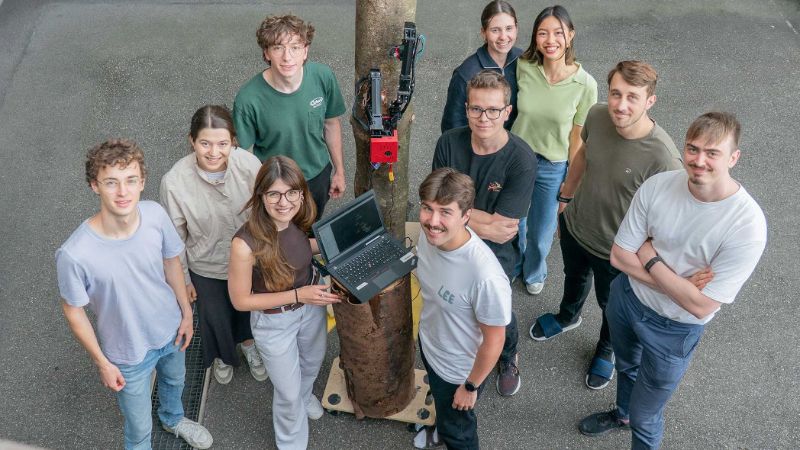Robots that can climb trees or restore coral reefs
From an AI-based cage system for laboratory mice, and robots designed for use on land, in the water, or on the moon, to innovative propulsion systems for aircraft, racing cars, rockets and pods. The Focus project teams complete the entire process independently – starting with the initial project idea and design studies through to the search for sponsors and production. These are the projects they have implemented this year:
MONKEE – Tree-climbing robot
The MONKEE climbing robot has two arms and three adhesion points and can adeptly move around in trees, both vertically and sideways, adapting to different trunk shapes and surfaces. This allows it to navigate obstacles and to advance far into the tree canopy. An integrated modular platform provides a flexible foundation for a wide range of applications, allowing for integration of future capabilities, such as CO₂ measurements, collection of samples, and sensor deployment. MONKEE allows comprehensive data gathering for tree canopy research, helping us gain a better understanding of the climate and biodiversity preservation.
ReefRanger – Robotics for reef restoration
Coral reefs provide a habitat to numerous marine species, perform crucial environmental functions and are one of the ecosystems most endangered by climate change. To support their regeneration, coral is grown in underwater farms. The ReefRanger Focus project has developed an autonomous underwater robot to carry out the labour-intensive and time-consuming tasks of feeding and monitoring the coral under water. Equipped with a camera, sensors and machine learning capability, it recognises table corals, navigates to them directly and supplies the coral with nutrients and probiotics. Its soft, flexible feeding mechanism protects the delicate corals. ReefRanger makes the restoration of coral reefs more efficient and scalable.
ARGOS – Welfare monitoring for mechatronic mouse enclosures
The ARGOS Focus project is developing a smart cage system for laboratory mice that meets current animal welfare standards and complies with the latest monitoring requirements. A highly integrated, mechatronic system continuously tracks the mice’s activity and behaviour, as well as various animal welfare aspects such as water and food intake. This allows real-time monitoring of the animals’ well-being. The team is collaborating on this project with experts from neurosciences, ethics, animal welfare, veterinary medicine and the ETH AI Center.
Other Focus projects in 2024/25
- ASIRA – Adaptable self-optimising robotic arm: The ASIRA project is developing a versatile industrial robot that can be used for a variety of automation tasks. The Focus project aims to deliver energy-efficient performance through weight reduction, modularity and optimised topology. Using a digital twin, an algorithm continuously adapts the geometry and rigidity. The result is an efficient and versatile prototype that can be used for a range of applications.
- CELLSIUS H2 – Where sustainability takes flight: The CELLSIUS H2 project is developing a hydrogen-powered propulsion system for small aircraft. The goal is to integrate the system into a light aircraft from the manufacturer Sling – with a focus on safety and efficiency. The team is building the central components itself, testing them using simulations and working closely with the regulatory authorities ahead of the planned maiden flight in 2025.
- Formula Student Electric – AMZ Racing: Students from the Academic Motorsport Association Zurich (AMZ) are completely re-designing an all-electric racing car that can be driven autonomously. The powertrain, chassis, aerodynamics and electronics will be developed in the space of four months. The vehicle will then be manufactured, assembled and tested. The team’s aim is to take part in the international Formula Student championship in the summer.
- HEPHAESTUS – Bi-liquid rocket engine: The HEPHAESTUS project is developing a novel liquid propellant rocket engine. It will be lighter and more compact than previous models and increase thrust from 700 newtons to between 4 and 5 kilonewtons. The goal is to integrate the engine into a launch vehicle and to take part in the European Rocketry Challenge. The design is being optimised in collaboration with industrial partners in several test runs.
- SERENITY: The SERENITY project involves developing a lightweight, robust robot for planetary missions. Equipped with omnidirectional spring structures, jumping mechanisms and an AI-based control system, it can navigate tough terrain, such as lava tubes. Thanks to innovative impact absorption, it can withstand heavy landings from great heights. On the ground, it will use lidar to map tunnel systems and analyse gas composition.
- SWARM – Pioneering autonomous underwater robotics: The SWARM project is developing a swarm of autonomous underwater robots that can collect and map 3D data on Swiss lakes. In collaboration with ARIS and the Swiss aquatic research institute Eawag, the team is investigating the spread of antibiotic-resistant bacteria in Lake Geneva. The system functions without GPS, integrates wireless communication and uses highly developed algorithms to coordinate its movement with a view to applications in extreme environments, including exploration of other planets.
- Swissloop – A new way of transportation: Faster than a plane and more efficient than a train – the Hyperloop, which involves travelling in suspended pods through virtually airless tubes, has the potential to transform the future of transportation. Building on previous work, the 2024/25 team is focusing on improvements to the drive-, levitation- and control systems, and the integration of a booster motor. Vacuum and passenger compatibility is also being further optimised.
- Way of Water – Choreographing light and water in motion: The Way of Water project is developing a fleet of water-based drones equipped with light sources that can execute choreographies on water. The team’s aim is to build a robust, durable and cost-effective system that is suitable for long-term use. A specifically developed algorithm controls and coordinates the drones in the swarm.
